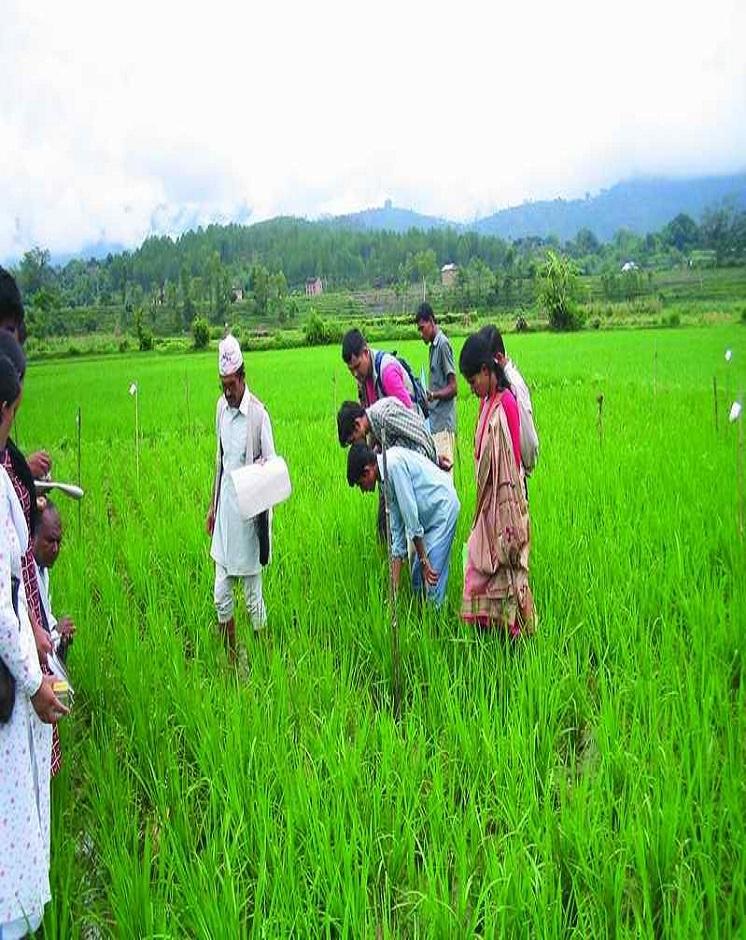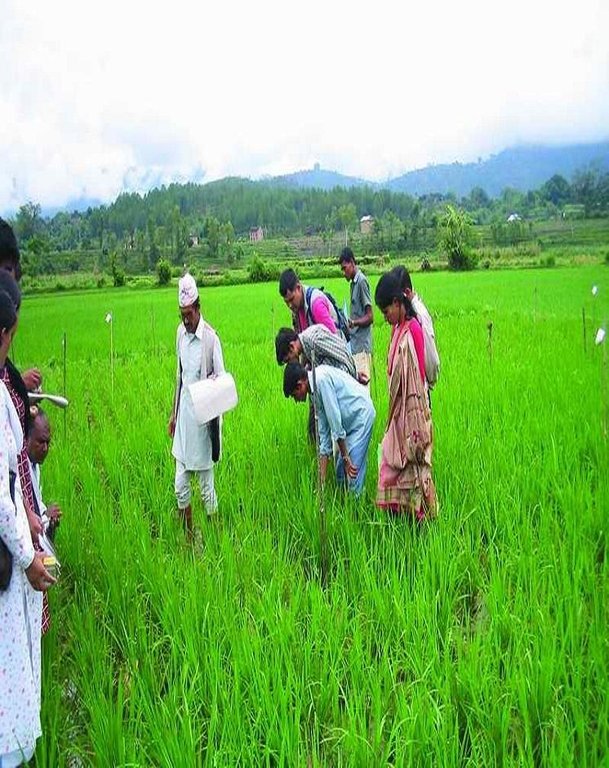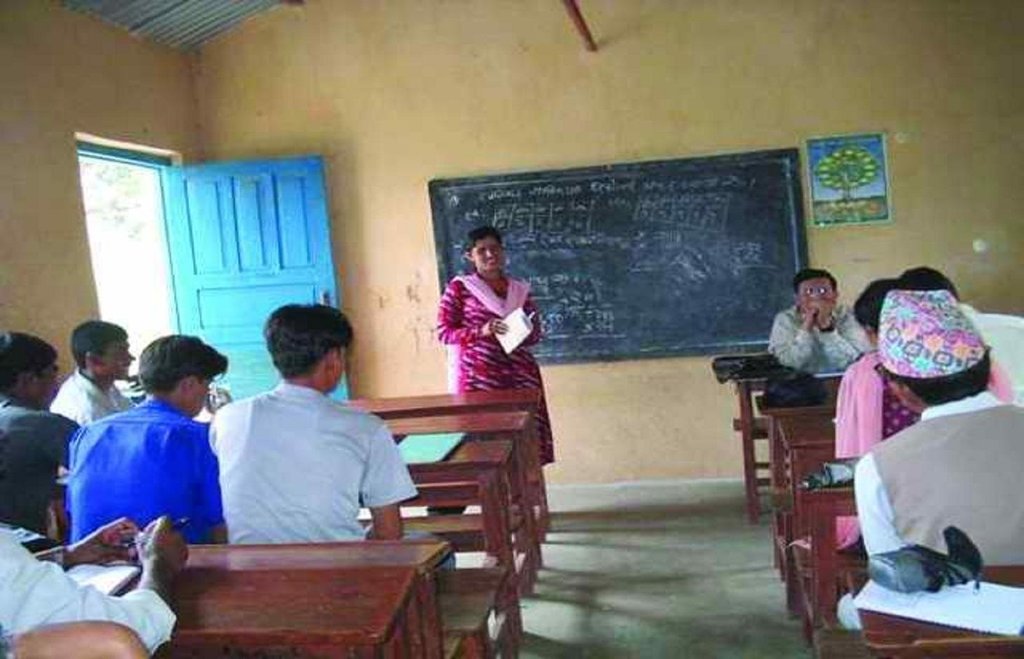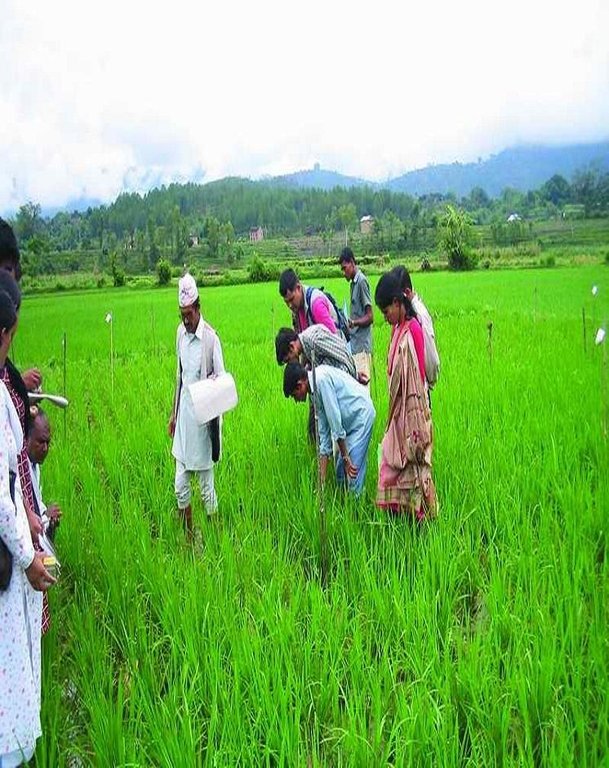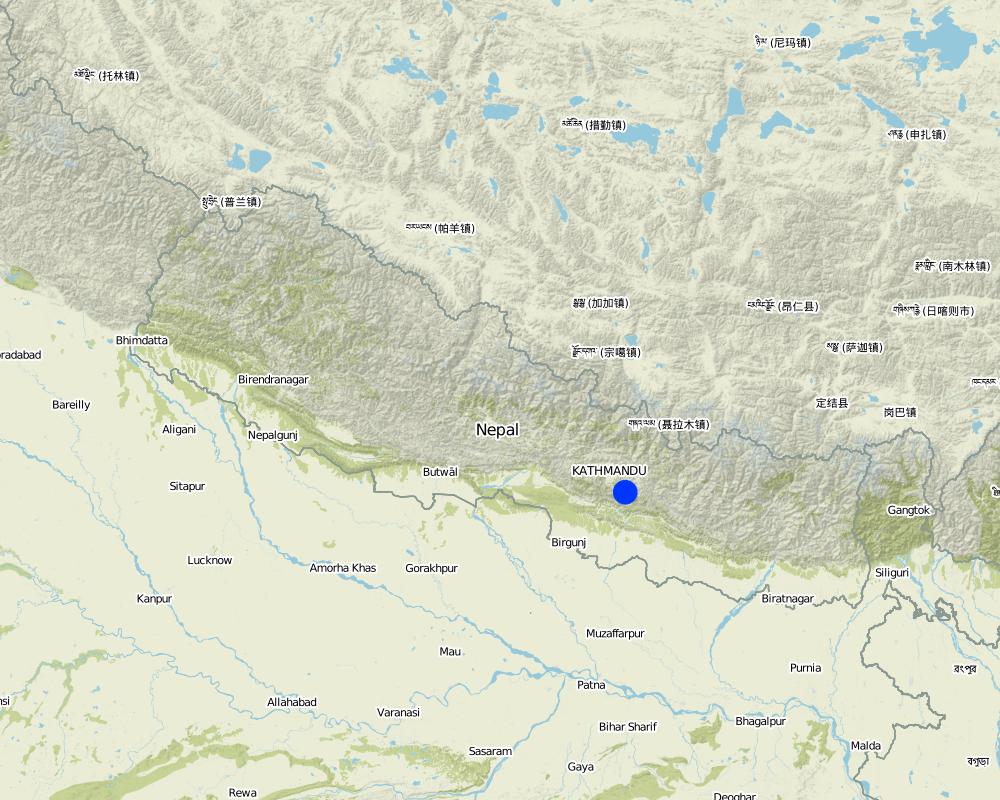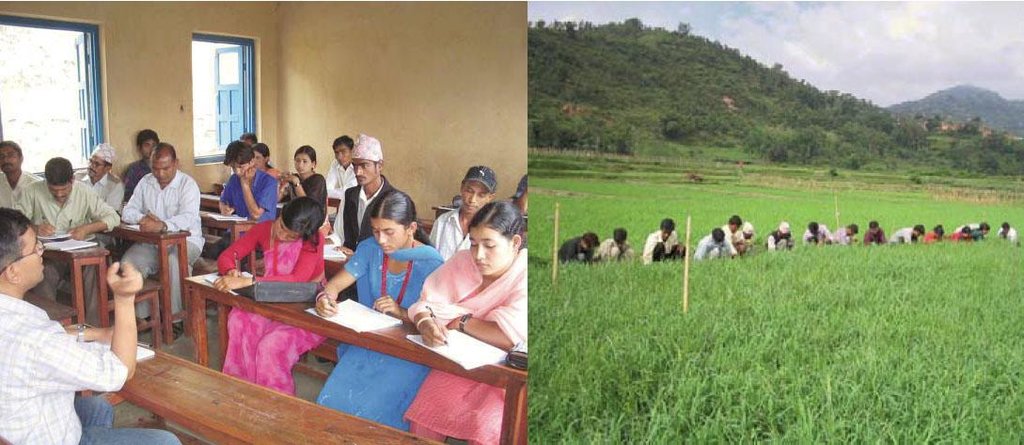Evaluation of the System of Rice Intensification through participatory research and development [Nepal]
- Creación:
- Actualización:
- Compilador: Madhav Dhakal
- Editor: –
- Revisor: Fabian Ottiger
Sahabhagitamulak anusandhan ra bikas dwara dhan uttpadan bridhhi garne tarika ko mulyankan (Nepali)
approaches_2550 - Nepal
Visualizar secciones
Expandir todo Colapsar todos1. Información general
1.2 Detalles de contacto de las personas de referencia e instituciones involucradas en la evaluación y la documentación del Enfoque
Especialista MST:
Nombre de la(s) institución(es) que facilitaron la documentación/ evaluación del Enfoque si fuera relevante)
CDE Centre for Development and Environment (CDE Centre for Development and Environment) - SuizaNombre de la(s) institución(es) que facilitaron la documentación/ evaluación del Enfoque si fuera relevante)
ICIMOD International Centre for Integrated Mountain Development (ICIMOD) - Nepal1.3 Condiciones referidas al uso de datos documentados mediante WOCAT
El compilador y la/s persona(s) de referencia claves aceptan las condiciones acerca del uso de los datos documentados mediante WOCAT :
Sí
1.4 Referencia/s al/los Cuestionario(s) de Tecnologías MST
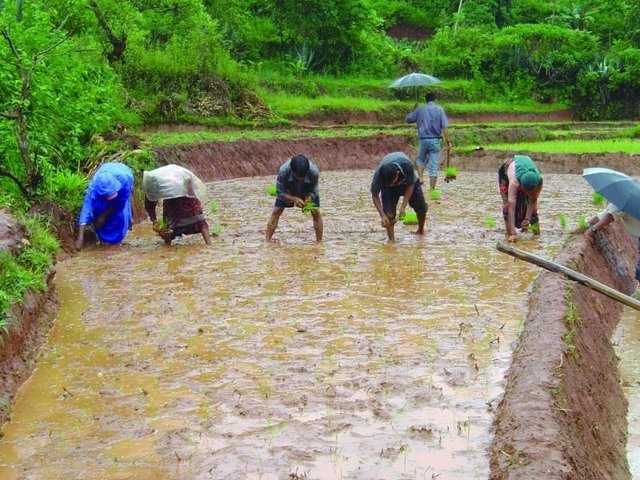
System of Rice Intensification [Nepal]
A method for increasing the productivity of rice by changing the management of plants, soil, water, and nutrients.
- Compilador: Madhav Dhakal
2. Descripción del Enfoque MST
2.1 Breve descripción del Enfoque
Conducting participatory action research with farmers and district level line agencies for demonstrating, disseminating and scaling up SRI
2.2 Descripción detallada del Enfoque MST
Descripción detallada del Enfoque MST:
Aims / objectives: PARDYP pilot tested SRI in the Spice Crop Development Centre (SCDC) at Tamaghat, Kavrepalanchok in 2002. The positive results led the technique to be tried out in 25 farmer’s fields in 2004 to evaluate whether SRI was technically feasible in the Himalayan middle mountains. Based on farmers’ interests and to promote SRI systematically, PARDYP organised interaction programmes between farmers who had and had not used SRI, village level group discussions, farmer-to-farmer visits and farmer-led on-site monitoring and evaluation in 2002, 2003 and 2004.
Methods: In 2005, the emphasis shifted to carrying out research with groups of farmers in a more systematic way and participatory rural appraisal methods and tools were used. The approach was called the SRI farmer field school (FFS) approach. Lead farmers (13 male and 6 female) were trained as SRI trainers and then facilitated village level farmer field schools for testing and promoting SRI. In 2005, SRI farmer field schools were run in 15 villages for about 100 farmers. Each school carried out hands-on training sessions to help farmers understand (1) the basic concepts of SRI and its practices, (2) methods for comparing traditional practices with SRI, and (3) how to observe, analyse and present findings more systematically. Monitoring and evaluation gathered both men’s and women’s perceptions. This also helped establish an informal farmer-learning network in the watershed. Village level discussions, farmer visits, and interaction with staff from the district agriculture offices continued. At the end of the on-farm experiments, a district level farmer’s day was organised to share the experiences gained.
Other important information: To promote wider understanding of the action research and encourage farmers to continue developing and adapting SRI, the project disseminated information about SRI through information, education and communication (IEC) materials aimed at community-level users, and a multi-media package on a CD ROM for the global audience and Nepali policy-makers and administrators. A national exchange workshop was held to share experiences from across the country on the use of SRI.
2.3 Fotos del Enfoque
2.5 País/ región/ lugares donde el Enfoque fue aplicado
País:
Nepal
Especifique más el lugar :
Kavrepalanchowk/ Jhikhu Khola watershed
Map
×2.6 Fechas de inicio y conclusión del Enfoque
Año de conclusión (si el Enfoque ya no se aplica):
2005
2.7 Tipo de Enfoque
- proyecto/ basado en un programa
2.8 Propósitos/ objetivos principales del Enfoque
The Approach focused mainly on SLM with other activities (Rice cultivation, watersaving, agronomic innovation)
- To demonstrate and evaluate the innovative SRI technique under local conditions with land users' participation. - To inform farmers about the basic concepts, associated principles, and technical know-how related to SRI. - To share knowledge gained on SRI with a wider audience. - To scale up the innovation across larger areas
The SLM Approach addressed the following problems: - Lack of systematic on-farm research for developing a technology that takes into account farmers' needs. - Weak institutional collaboration for technology development, dissemination and scaling up. - Poor soil fertility, limited crop production, and poor irrigation facilities
2.9 Condiciones que facilitan o impiden la implementación de la/s Tecnología/s aplicadas bajo el Enfoque
disponibilidad/ acceso a recursos y servicios financieros
- impiden
Government incentives lacking
Treatment through the SLM Approach: The innovation is cost effective and doesn't need additional inputs
entorno institucional
- impiden
Lack of cordination among land users
Treatment through the SLM Approach: Informal SRI farmers network established with trained human resources.
marco de trabajo legal (tenencia de tierra, derechos de uso de tierra y agua)
- facilitan
The existing land ownership, land use rights / water rights greatly helped the approach implementation: The individual land use rights helped in implementing the technology as there were no conflicts among land users.
conocimiento de MST, acceso a apoyo técnico
- impiden
It is not a priority area of line agencies
Treatment through the SLM Approach: Sharing of technical know how with concerned stakeholders
otros
- impiden
lack of awareness
Treatment through the SLM Approach: Trainings, group discussions , field visits
3. Participación y roles de las partes interesadas involucradas
3.1 Partes interesadas involucradas en el Enfoque y sus roles
- usuarios locales de tierras/ comunidades locales
Spices Crop Development Centre and farmer groups
Women are generally busy with in-house work. There was only 30 % women participation. Initially SRI was demonstrated onindividual farmers' field. Working land users were mainly men (about 30 percent were women), villlage level groups were formed.
- ONG
PARDYP project
- gobierno nacional (planificadores, autoridades)
- organización internacional
Si varias partes interesadas estuvieron involucradas, indique la agencia principal:
Concept and orientation - national specialists and implementation of the approach jointly with land users.
3.2 Involucramiento de los usuarios locales de tierras/ comunidades locales en las distintas fases del Enfoque
| Involucramiento de los usuarios locales de tierras/ comunidades locales | Especifique quién se involucró y describa las actividades | |
|---|---|---|
| iniciación/ motivación | pasivo | public meetings; First year's on-station demonstration with results shared at public meetings |
| planificación | interactivo | public meetings; Public meetings organised in different villages; villagers selected lead farmers for the training, and orientation meeting held to plan activities |
| implementación | interactivo | responsibility for major steps; Farmers themselves implemented the activities; the project facilitated the research and arranged logistics |
| monitoreo y evaluación | interactivo | Measurements, observations and reporting were carried out once a week. At the end of the project, results were evaluated through interviews using questionnaires. Public meeting organised to share results with district level stakeholders |
| Research | interactivo | On-farm and on-station research conducted; information from research station collected by technicians; farmers themselves collected information from their fields |
3.3 Flujograma (si estuviera disponible)
Descripción:
left: Public meeting: an orientation meeting to plan and implement SRI activities. Right: Lead farmers in the demonstration field – an activity of a farmer field school.
Autor:
Madhav Dhakal
3.4 La toma de decisiones en la selección de Tecnología(s) MST
Especifique quién decidió la selección de las Tecnología/ Tecnologías a implementarse:
- principalmente por especialistas MST en consulta con usuarios de tierras
Explique:
SRI is being tested in many countries in Asia and rest of the world with proven benefits. Project staff shared SRI principles and methods with the watershed-farmers, few of them came forward and tested it to observe the performance in the local condition.
Decisions on the method of implementing the SLM Technology were made by mainly by SLM specialists with consultation of land users. It was tested first at a research station to build confidence of project staff and surrounding villagers, and was then taken to interested farmers' fields
4. Apoyo técnico, fortalecimiento institucional y gestión del conocimiento
4.1 Construcción de capacidades / capacitación
¿Se proporcionó la capacitación a usuarios de tierras/ otras partes interesadas?
Sí
Especifique quién fue capacitado:
- usuarios de tierras
- personal de campo/ consejeros
Forma de capacitación:
- de agricultor a agricultor
- áreas de demostración
- reuniones públicas
- cursos
Temas avanzados:
The principles associated with SRI, participatory research procedures, and farmers' concerns (men and women).
4.2 Servicio de asesoría
¿Los usuarios de tierras tienen acceso a un servicio de asesoría?
Sí
Especifique si servicio proporcionado se realizó:
- en los campos de los usuarios de tierras
Describa/ comentarios:
Name of method used for advisory service: Farmer - to - Farmer Extension of SRI; Key elements: Use of local farmers as facilitators, Farmer - to - farmer visits, Public meetings , national workshop; 1) Advisory service was carried out through: projects own extension structure and agents; Extension staff: specifically hired project employees 2) Target groups for extension: land users; Activities: trainings, group discussions, farm visits
Advisory service is quite adequate to ensure the continuation of land conservation activities; Large number of farmers can now implement SRI with confidence, there are 15 local trainers who can train many farmers, which insures the continuation of SRI activities .
4.3 Fortalecimiento institucional (desarrollo institucional)
¿Se establecieron o fortalecieron instituciones mediante el Enfoque?
- no
4.4 Monitoreo y evaluación
¿El monitoreo y la evaluación forman parte del Enfoque?
Sí
Comentarios:
bio-physical aspects were ad hoc monitored through observations; indicators: soil condition and irrigation facilities
technical aspects were regular monitored through measurements; indicators: number of tillers, tiller height, climatic conditions
socio-cultural aspects were ad hoc monitored by 0 through observations; indicators: preference for rice varieties
economic / production aspects were regular monitored through observations; indicators: grain and biomass production, cost of production
area treated aspects were ad hoc monitored through measurements; indicators: area of SRI cultivation
no. of land users involved aspects were ad hoc monitored through observations; indicators: frequency of farm visits and record keeping
management of Approach aspects were regular monitored through observations; indicators: training management by farmer field school management sub-committees
4.5 Investigación
¿La investigación formó parte del Enfoque?
Sí
- Comparision between traditional and SRI methods
Proporcione detalles adicionales e indique quién hizo la investigación:
Participatory research at the farmer field schools was a key element of the approach. The schools compared the inputs and outputs of the traditional and SRI methods including the differences in grain and biomass production, the costs and benefits, and the advantages and disadvantages.
Research was carried out both on station and on-farm
5. Financiamiento y apoyo material externo
5.1 Presupuesto anual para el componente MST del Enfoque
Si no se conoce el presupuesto anual preciso, indique el rango:
- 2,000-10,000
Comentarios (ej. fuentes principales de financiamiento/ donantes principales):
Approach costs were met by the following donors: international (SDC, IDRC, ICIMOD): 90.0%; other (Jhikhu Khola farmers): 10.0%
5.2 Apoyo financiero/material proporcionado a los usuarios de tierras
¿Los usuarios de tierras recibieron financiamiento/ apoyo material para implementar la Tecnología/ Tecnologías? :
Sí
5.3 Subsidios para insumos específicos (incluyendo mano de obra)
- agrícola
| Especifique qué insumos se subsidiaron | En qué grado | Especifique los subsidios |
|---|---|---|
| semillas | on- station and on- farm demonstration sites only | |
| fertilizantes | on- station and on- farm demonstration sites only | |
| Biocides | on- station and on- farm demonstration sites only | |
Si la mano de obra de usuarios de tierras fue un insumo sustancial, ¿fue:
- voluntario?
Comentarios:
Farmers worked either as a trainee or as a volunteer.
5.4 Crédito
¿Se proporcionó crédito bajo el Enfoque para actividades MST?
No
6. Análisis de impacto y comentarios de conclusión
6.1 Impactos del Enfoque
¿El Enfoque ayudó a los usuarios de tierras a implementar y mantener Tecnologías MST?
- No
- Sí, un poco
- Sí, moderadamente
- Sí, mucho
The approach has helped participating farmers to improve soil and water management. They started to apply the recommended dose of chemical fertiliser and improved farmyard manure. The frequency of irrigation was reduced and there were less cases of terrace-riser failure caused by stagnant water. The
Did other land users / projects adopt the Approach?
- No
- Sí, un poco
- Sí, moderadamente
- Sí, mucho
A similar approach was used to promote SRI by a few projects in the same district.
Did the Approach lead to improved livelihoods / human well-being?
- No
- Sí, un poco
- Sí, moderadamente
- Sí, mucho
Through better management of rice crop
6.2 Motivación principal del usuario de la tierra para implementar MST
- producción incrementada
Increased (nearly doubled) production
- incremento de la renta(bilidad), proporción mejorada de costo-beneficio
Increased production with same or little less cost input
- conciencia medioambiental
Improved land and water management
6.3 Sostenibilidad de las actividades del Enfoque
¿Pueden los usuarios de tierras sostener lo que se implementó mediante el Enfoque (sin apoyo externo)?
- sí
Si respondió que sí, describa cómo:
About 35 local land users had adopted the SRI method and previous adopters were continuing to use SRI method. However, some more time may be required for its wider adoption.
6.4 Fortalezas/ ventajas del Enfoque
| Fuerzas/ ventajas/ oportunidades desde la perspectiva del usuario de la tierra |
|---|
| Through farmer-to-farmer fi eld visits, farmers had an opportunity to observe others' fi elds and see the performance of SRI in different locations and conditions. (How to sustain/ enhance this strength: Continue such visits as farmers learn much more from farm visits and from sharing experiences with other farmers.) |
| Fuerzas/ ventajas/ oportunidades desde la perspectiva del compilador o de otra persona de referencia clave |
|---|
| Lead farmers served as key resource persons in the village-level farmer field schools. Data from test plots were analyzed by farmers on a weekly basis. This was very effective for promoting the sustainability of SRI. (How to sustain/ enhance this strength: Encourage district level agriculture offi ces to use the skills of lead farmers as resource persons to expand SRI in their districts.) |
| Action research was conducted through farmer field schools and lead farmers were trained in training of trainers programmes. These served as platforms for farmers to share their immediate concerns. Besides analysing and presenting, farmers' skills were also developed. (How to sustain/ enhance this strength: Implement the farmers fi eld school approach during technology implementation to build confi dence of land users and empower them in soil and water conservation.) |
| Participatory methods and tools were applied repeatedly. Farmer visits and village level group discussions were very effective for evaluating SRI. (How to sustain/ enhance this strength: Use participatory tools and methods widely during the technology implementing period) |
| Action research was conducted with farmer groups and individual households. The group approach was more systematic and helped to build confidence of land users in the technology (How to sustain/ enhance this strength: It should be maintained and continued on a regular basis to strengthen land users' involvement) |
6.5 Debilidades/ desventajas del Enfoque y formas de sobreponerse a ellos
| Debilidades/ desventajas/ riesgos desde la perspectiva del usuario de la tierra | ¿Cómo sobreponerse a ellas? |
|---|---|
| A long dry spell meant that the SRI observation plot could not be established near to the lead farmers' fi eld school site, and only 15 facilitators were able to establish observation plots in their villages. | This was due to natural causes (late arrival of monsoon), it can be improved easily if monsoon arrives on time. |
| Debilidades/ desventajas/ riesgos desde la perspectiva del compilador o de otra persona de referencia clave | ¿Cómo sobreponerse a ellas? |
|---|---|
| Agro-ecosystem analysis, as used at the farmer fi eld schools, became a time-consuming process as participants had to spend much time in preparing presentations. | Pre-planning and pre-preparation of presentation format should reduce the time length |
| Women's participation in the village level workshops was poor (2% at one location and 5% at another) | Encourage women to participate, and adapt programmes to suit their interests. |
| Due to time limits, not all SRI adopters' opinions and experiences could be covered during interaction workshops. The scattered farmer field schools (distance-wise) and the diffi cult political situation meant that exchange visits could not be organised for all schools. | Allocate enough time for such programmes |
7. Referencias y vínculos
7.1 Métodos/ fuentes de información
- visitas de campo, encuestas de campo
- entrevistas con usuarios de tierras
7.2 Referencias a publicaciones disponibles
Título, autor, año, ISBN:
Dhakal, M.P. (2005) Farmers' Evaluation of System of Rice Intensifi cation in Middle Mountains of Nepal.Cornell International Institute for Food, Agriculture, and Development (CIIFAD)ICIMOD (2007) Good Practices in Watershed Management, Lessons Learned in the Mid Hills of Nepal. KathmanduIRRI - International Rice Research Institute.
¿Dónde se halla disponible? ¿Costo?
ICIMOD, SRI.URL: http://ciifad.cornell.edu/sri/countries/nepal/index.htmlICIMODwww.irri.org.
Título, autor, año, ISBN:
ICIMOD (2007) Good Practices in Watershed Management, Lessons Learned in the Mid Hills of Nepal. Kathmandu
¿Dónde se halla disponible? ¿Costo?
ICIMOD
Título, autor, año, ISBN:
IRRI - International Rice Research Institute.
¿Dónde se halla disponible? ¿Costo?
www.irri.org.
Vínculos y módulos
Expandir todo Colapsar todosVínculos

System of Rice Intensification [Nepal]
A method for increasing the productivity of rice by changing the management of plants, soil, water, and nutrients.
- Compilador: Madhav Dhakal
Módulos
No se hallaron módulos


